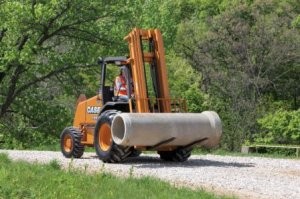Case launches H Series rough terrain forklifts
Machines deliver superior fuel economy, productivity and lift speed

Case Construction Equipment recently announced the introduction of two new H Series rough terrain forklifts, offering enhanced fuel economy and productivity along with industry-leading lift speed and dependable, high-performance lift capacities.
The Case 586H and 588H forklifts achieve Tier 4 Interim certification through the use of cooled exhaust gas recirculation (CEGR) technology and a diesel particulate filter. Both models feature Case turbocharged engines rated at 78 net hp (58 kW) that deliver a minimum five-percent increase in fuel efficiency and faster response times than previous models, while meeting current emission standards.
“While fuel economy is a top benefit of the Case H Series forklifts, the new models incorporate a variety of improvements that increase productivity, including an enhanced operator environment and easier serviceability,” said Katie Pullen, Case brand marketing manager.
Case H Series forklifts are designed to operate in a variety of terrains, with optional four-wheel drive, standard differential lock, 60 degrees of mast tilt and optional load control to safeguard loads at travels speeds up to 24 mph (39 km/h). For operations in confined areas, both models feature a narrow, zero-tail swing design. The Case rough terrain forklifts feature an industry standard ITA Class 3 carriage and forks, allowing a wide range of aftermarket attachments.
With a standard 15-foot mast, the Case 586H forklift has a minimum operating weight of 13,228 lb (6,000 kg), lift capacity of 6,000 lb (2,722 kg), and lift speed of 107 ft/min (0.55 m/sec). The Case 588H forklift features a minimum operating weight of 15,639 lb (7,094 kg), lift capacity of 8,000 lb (3,628 kg), and lift speed of 106 ft/min (0.54 m/sec). Both models are available with 22-ft (6.7-m) masts.
The Case H Series forklifts offer many of the same powertrain components that are standard on the company’s industry-leading N Series loader/backhoes, including the engines and axles. Unlike the Case loader/backhoes, the H Series forklifts feature hydraulically actuated, wet disc brakes that do not include a power-assist capability.
“Brakes on the H Series machines provide greater operator control in the applications where rough terrain forklifts are used,” Pullen said. “Customers that operated prototype units of the new H Series forklifts told us the traditional brakes gave them a better feel for inching forward while lifting and placing loads, compared with the performance of power-assist brakes.”
Designed for operator comfort, visibility
The Case H Series forklifts feature a deluxe suspension seat and a spacious operating platform, keeping operators comfortable and productive on the job. Controls are easy to use which helps experienced and novice operators move more materials.
The tapered rear hood and wide-channel dual-mast cylinders result in unmatched visibility for the operator. The narrow operating console increases front visibility. Optional deluxe suspension seat and load control combine to provide a comfortable ride on any terrain.
Easy serviceability maximizes uptime
Case H Series forklifts help contractors maximize uptime by simplifying daily maintenance. No-tool swing-out access doors, vertical spin-on filters and grouped, ground-level service checks streamline engine access and routine maintenance.
The outboard wet disc brake design on the Case H Series forklifts enables technicians to service the brakes by removing only the outer components that are easy to access, such as the tires and rims, eliminating the need to drop the axles. This arrangement drastically decreases the time required to service the brakes. Also, the larger brake surface helps extend brake life and reduce the frequency of brake repairs.
The roller mast design, by minimizing the possibility of debris accumulation, assures smoother lifting, longer component life and reduced maintenance costs.


